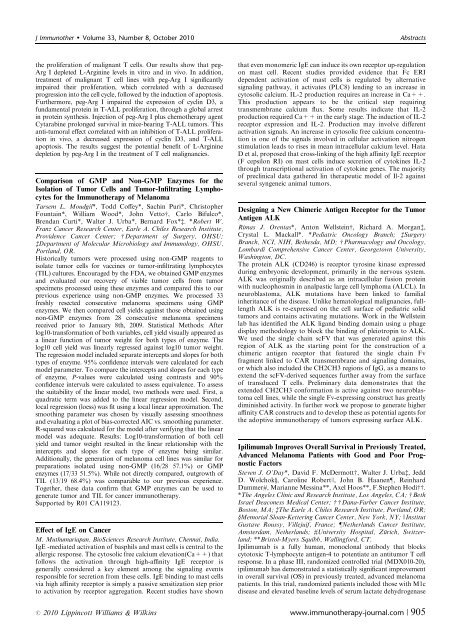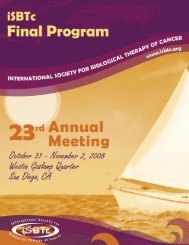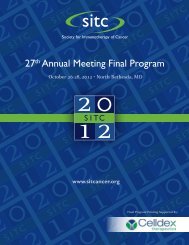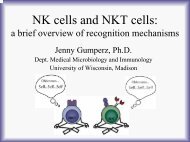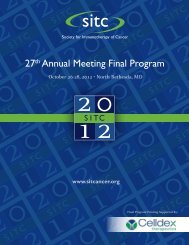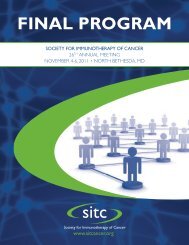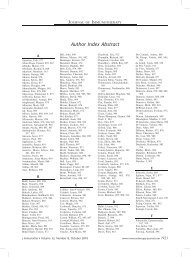Abstracts for the 25th Annual Scientific Meeting of the International ...
Abstracts for the 25th Annual Scientific Meeting of the International ...
Abstracts for the 25th Annual Scientific Meeting of the International ...
Create successful ePaper yourself
Turn your PDF publications into a flip-book with our unique Google optimized e-Paper software.
J Immuno<strong>the</strong>r Volume 33, Number 8, October 2010<br />
<strong>Abstracts</strong><br />
<strong>the</strong> proliferation <strong>of</strong> malignant T cells. Our results show that peg-<br />
Arg I depleted L-Arginine levels in vitro and in vivo. In addition,<br />
treatment <strong>of</strong> malignant T cell lines with peg-Arg I significantly<br />
impaired <strong>the</strong>ir proliferation, which correlated with a decreased<br />
progression into <strong>the</strong> cell cycle, followed by <strong>the</strong> induction <strong>of</strong> apoptosis.<br />
Fur<strong>the</strong>rmore, peg-Arg I impaired <strong>the</strong> expression <strong>of</strong> cyclin D3, a<br />
fundamental protein in T-ALL proliferation, through a global arrest<br />
in protein syn<strong>the</strong>sis. Injection <strong>of</strong> peg-Arg I plus chemo<strong>the</strong>rapy agent<br />
Cytarabine prolonged survival in mice-bearing T-ALL tumors. This<br />
anti-tumoral effect correlated with an inhibition <strong>of</strong> T-ALL proliferation<br />
in vivo, a decreased expression <strong>of</strong> cyclin D3, and T-ALL<br />
apoptosis. The results suggest <strong>the</strong> potential benefit <strong>of</strong> L-Arginine<br />
depletion by peg-Arg I in <strong>the</strong> treatment <strong>of</strong> T cell malignancies.<br />
Comparison <strong>of</strong> GMP and Non-GMP Enzymes <strong>for</strong> <strong>the</strong><br />
Isolation <strong>of</strong> Tumor Cells and Tumor-Infiltrating Lymphocytes<br />
<strong>for</strong> <strong>the</strong> Immuno<strong>the</strong>rapy <strong>of</strong> Melanoma<br />
Tarsem L. Moudgil*, Todd C<strong>of</strong>fey*, Sachin Puri*, Christopher<br />
Fountain*, William Wood*, John Vettow, Carlo Bifulco*,<br />
Brendan Curti*, Walter J. Urba*, Bernard Fox*z. *Robert W.<br />
Franz Cancer Research Center, Earle A. Chiles Research Institute,<br />
Providence Cancer Center; w Department <strong>of</strong> Surgery, OHSU;<br />
zDepartment <strong>of</strong> Molecular Microbiology and Immunology, OHSU,<br />
Portland, OR.<br />
Historically tumors were processed using non-GMP reagents to<br />
isolate tumor cells <strong>for</strong> vaccines or tumor-infiltrating lymphocytes<br />
(TIL) cultures. Encouraged by <strong>the</strong> FDA, we obtained GMP enzymes<br />
and evaluated our recovery <strong>of</strong> viable tumor cells from tumor<br />
specimens processed using <strong>the</strong>se enzymes and compared this to our<br />
previous experience using non-GMP enzymes. We processed 33<br />
freshly resected consecutive melanoma specimens using GMP<br />
enzymes. We <strong>the</strong>n compared cell yields against those obtained using<br />
non-GMP enzymes from 28 consecutive melanoma specimens<br />
received prior to January 8th, 2009. Statistical Methods: After<br />
log10-trans<strong>for</strong>mation <strong>of</strong> both variables, cell yield visually appeared as<br />
a linear function <strong>of</strong> tumor weight <strong>for</strong> both types <strong>of</strong> enzyme. The<br />
log10 cell yield was linearly regressed against log10 tumor weight.<br />
The regression model included separate intercepts and slopes <strong>for</strong> both<br />
types <strong>of</strong> enzyme. 95% confidence intervals were calculated <strong>for</strong> each<br />
model parameter. To compare <strong>the</strong> intercepts and slopes <strong>for</strong> each type<br />
<strong>of</strong> enzyme, P-values were calculated using contrasts and 90%<br />
confidence intervals were calculated to assess equivalence. To assess<br />
<strong>the</strong> suitability <strong>of</strong> <strong>the</strong> linear model, two methods were used. First, a<br />
quadratic term was added to <strong>the</strong> linear regression model. Second,<br />
local regression (loess) was fit using a local linear approximation. The<br />
smoothing parameter was chosen by visually assessing smoothness<br />
and evaluating a plot <strong>of</strong> bias-corrected AIC vs. smoothing parameter.<br />
R-squared was calculated <strong>for</strong> <strong>the</strong> model after verifying that <strong>the</strong> linear<br />
model was adequate. Results: Log10-trans<strong>for</strong>mation <strong>of</strong> both cell<br />
yield and tumor weight resulted in <strong>the</strong> linear relationship with <strong>the</strong><br />
intercepts and slopes <strong>for</strong> each type <strong>of</strong> enzyme being similar.<br />
Additionally, <strong>the</strong> generation <strong>of</strong> melanoma cell lines was similar <strong>for</strong><br />
preparations isolated using non-GMP (16/28 57.1%) or GMP<br />
enzymes (17/33 51.5%). While not directly compared, outgrowth <strong>of</strong><br />
TIL (13/19 68.4%) was comparable to our previous experience.<br />
Toge<strong>the</strong>r, <strong>the</strong>se data confirm that GMP enzymes can be used to<br />
generate tumor and TIL <strong>for</strong> cancer immuno<strong>the</strong>rapy.<br />
Supported by R01 CA119123.<br />
Effect <strong>of</strong> IgE on Cancer<br />
M. Muthumariapan. BioSciences Research Institute, Chennai, India.<br />
IgE -mediated activation <strong>of</strong> basphils and mast cells is central to <strong>the</strong><br />
allergic response. The cytosolic free calcium elevation(Ca++) that<br />
follows <strong>the</strong> activation through high-affinity IgE receptor is<br />
generally considered a key element among <strong>the</strong> signaling events<br />
responsible <strong>for</strong> secretion from <strong>the</strong>se cells. IgE binding to mast cells<br />
via high affinity receptor is simply a passive sensitization step prior<br />
to activation by receptor aggregation. Recent studies have shown<br />
that even monomeric IgE can induce its own receptor up-regulation<br />
on mast cell. Recent studies provided evidence that Fc ERI<br />
dependent activation <strong>of</strong> mast cells is regulated by alternative<br />
signaling pathway, it activates (PLC8) lending to an increase in<br />
cytosolic calcium. IL-2 production requires an increase in Ca++.<br />
This production appears to be <strong>the</strong> critical step requiring<br />
transmembrane calcium flux. Some results indicate that IL-2<br />
production required Ca++ in <strong>the</strong> early stage. The induction <strong>of</strong> IL-2<br />
receptor expression and IL-2. Production may involve different<br />
activation signals. An increase in cytosolic free calcium concentration<br />
is one <strong>of</strong> <strong>the</strong> signals involved in cellular activation nitrogen<br />
stimulation leads to rises in mean intracellular calcium level. Hata<br />
D et al, proposed that cross-linking <strong>of</strong> <strong>the</strong> high affinity IgE receptor<br />
(F cepsilon RI) on mast cells induce secretion <strong>of</strong> cytokines IL-2<br />
through transcriptional activation <strong>of</strong> cytokine genes. The majority<br />
<strong>of</strong> preclinical data ga<strong>the</strong>red lin <strong>the</strong>rapeutic model <strong>of</strong> Il-2 against<br />
several syngeneic animal tumors.<br />
Designing a New Chimeric Antigen Receptor <strong>for</strong> <strong>the</strong> Tumor<br />
Antigen ALK<br />
Rimas J. Orentas*, Anton Wellsteinw, Richard A. Morganz,<br />
Crystal L. Mackall*. *Pediatric Oncology Branch; zSurgery<br />
Branch, NCI, NIH, Be<strong>the</strong>sda, MD; w Pharmacology and Oncology,<br />
Lombardi Comprehensive Cancer Center, Georgetown University,<br />
Washington, DC.<br />
The protein ALK (CD246) is receptor tyrosine kinase expressed<br />
during embryonic development, primarily in <strong>the</strong> nervous system.<br />
ALK was originally described as an intracellular fusion protein<br />
with nucleophosmin in analpastic large cell lymphoma (ALCL). In<br />
neuroblastoma, ALK mutations have been linked to familial<br />
inheritance <strong>of</strong> <strong>the</strong> disease. Unlike hematological malignancies, fulllength<br />
ALK is re-expressed on <strong>the</strong> cell surface <strong>of</strong> pediatric solid<br />
tumors and contains activating mutations. Work in <strong>the</strong> Wellstein<br />
lab has identified <strong>the</strong> ALK ligand binding domain using a phage<br />
display methodology to block <strong>the</strong> binding <strong>of</strong> pleiotropin to ALK.<br />
We used <strong>the</strong> single chain scFV that was generated against this<br />
region <strong>of</strong> ALK as <strong>the</strong> starting point <strong>for</strong> <strong>the</strong> construction <strong>of</strong> a<br />
chimeric antigen receptor that featured <strong>the</strong> single chain Fv<br />
fragment linked to CAR transmembrane and signaling domains,<br />
or which also included <strong>the</strong> CH2CH3 regions <strong>of</strong> IgG, as a means to<br />
extend <strong>the</strong> scFV-derived sequences fur<strong>the</strong>r away from <strong>the</strong> surface<br />
<strong>of</strong> transduced T cells. Preliminary data demonstrates that <strong>the</strong><br />
extended CH2CH3 con<strong>for</strong>mation is active against two neuroblastoma<br />
cell lines, while <strong>the</strong> single Fv-expressing construct has greatly<br />
diminished activity. In fur<strong>the</strong>r work we propose to generate higher<br />
affinity CAR constructs and to develop <strong>the</strong>se as potential agents <strong>for</strong><br />
<strong>the</strong> adoptive immuno<strong>the</strong>rapy <strong>of</strong> tumors expressing surface ALK.<br />
Ipilimumab Improves Overall Survival in Previously Treated,<br />
Advanced Melanoma Patients with Good and Poor Prognostic<br />
Factors<br />
Steven J. O’Day*, David F. McDermottw, Walter J. Urbaz, Jedd<br />
D. Wolchoky, Caroline RobertJ, John B. Haanenz, Reinhard<br />
Dummer#, Marianne Messina**, Axel Hoos**, F.Stephen Hodiww.<br />
*The Angeles Clinic and Research Institute, Los Angeles, CA; w Beth<br />
Israel Deaconess Medical Center; wwDana-Farber Cancer Institute,<br />
Boston, MA; zThe Earle A. Chiles Research Institute, Portland, OR;<br />
yMemorial Sloan-Kettering Cancer Center, New York, NY; JInstitut<br />
Gustave Roussy, Villejuif, France; zNe<strong>the</strong>rlands Cancer Institute,<br />
Amsterdam, Ne<strong>the</strong>rlands; #University Hospital, Zürich, Switzerland;<br />
**Bristol-Myers Squibb, Walling<strong>for</strong>d, CT.<br />
Ipilimumab is a fully human, monoclonal antibody that blocks<br />
cytotoxic T-lymphocyte antigen-4 to potentiate an antitumor T cell<br />
response. In a phase III, randomized controlled trial (MDX010-20),<br />
ipilimumab has demonstrated a statistically significant improvement<br />
in overall survival (OS) in previously treated, advanced melanoma<br />
patients. In this trial, randomized patients included those with M1c<br />
disease and elevated baseline levels <strong>of</strong> serum lactate dehydrogenase<br />
r 2010 Lippincott Williams & Wilkins www.immuno<strong>the</strong>rapy-journal.com | 905


